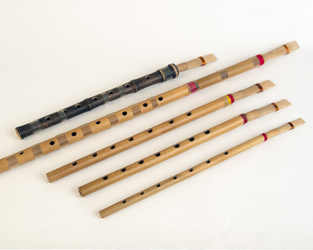Piri
Woodwinds
Asia
Between 1001 and 1900 AD
Video
The piri is a traditional Korean double-reed wind instrument that plays a significant role in both folk and classical music. Known for its bright, reedy sound, the piri has been an essential part of Korean musical culture for centuries.
Description
It is a cylindrical instrument made primarily from bamboo, typically measuring about 25 to 30 centimeters (approximately 10 to 12 inches) in length. The piri features a large double reed, which is inserted into the top of the bamboo body, producing its distinctive sound. The instrument has eight finger holes—seven on the front and one on the back for the thumb—allowing players to change pitch and create melodies.
Purpose
The piri serves multiple purposes in Korean music. It often plays the main melodic lines in traditional ensembles, providing a bright and penetrating sound that can cut through other instruments. The piri is commonly used in various ceremonial contexts, including weddings, shamanistic rituals, and traditional festivals.
History (Origin)
The piri has its origins in Central Asia and was introduced to Korea from China. Historical records indicate its use as early as the Three Kingdoms period, specifically in the states of Goguryeo and Baekje. Over time, the piri evolved into different forms suited for various musical contexts. Its integration into Korean court music and folk traditions solidified its place in the country’s cultural heritage.
How It Works
Sound production in the piri involves. When air is blown into the mouthpiece, the double reed vibrates, creating sound waves that travel through the air column inside the bamboo tube. Players can change pitch by covering or uncovering the finger holes along the body of the instrument. The use of breath control and embouchure is crucial for producing a steady sound.
Types
There are several types of piri based on their size and intended use:
- Hyangpiri: A larger version used in court music, known for its loud and nasal tone. It often plays prominent melodic parts in ensembles.
- Sepiri: A smaller variant that produces a softer sound, typically used in lyrical genres alongside voice or gentle string instruments.
- Tangpiri: Used in court music derived from Chinese traditions, this type is strident and suited for more formal performances.
- Daegeum: While not a type of piri, it is worth noting that it is another important double-reed instrument used alongside the piri in traditional Korean music.
Features
The piri allows for a wide range of expressive techniques, including vibrato, pitch bending, and glissando. Its dynamic range enables players to produce both loud passages and softer melodies. As a central instrument in traditional Korean music ensembles, the piri contributes to the rich tapestry of Korea’s musical heritage.
The piri (피리) is a traditional Korean double-reed wind instrument, integral to both folk and classical (court) music. Its distinctive, mellow sound and expressive capabilities have made it a central element in Korean musical ensembles.
Construction and Design
The piri is typically crafted from bamboo, featuring a cylindrical bore and eight finger holes—seven on the front and one on the back for the thumb. The instrument’s large double reed, known as the “seo,” contributes to its rich tonal quality. There are four primary types of piri, each suited to different musical contexts:
Hyangpiri (향피리): The longest and most common type, used in both folk and court music.
Sepiri (세피리): A smaller, thinner, and quieter version, often used in ensemble settings with voices or soft stringed instruments.
Dangpiri (당피리): A wider variant, similar to the Chinese guanzi, used in specific musical genres.
Daepiri (대피리): A modernized version with keys and a bell, resembling a Western oboe, primarily used in North Korea.
Playing Technique
Playing the piri requires precise control of the embouchure and breath support. Musicians employ circular breathing to produce continuous sound without interruption. The instrument’s expressive capabilities are enhanced through techniques such as vibrato, pitch bending, and sliding tones, allowing for nuanced and emotive performances.
Cultural Significance
The piri holds a prominent place in Korean culture, featured in various musical genres, including court music, folk music, and contemporary compositions. Its ability to mimic the human voice has made it a symbol of Korean musical identity. The instrument is often used in ensemble settings, contributing to the rich tapestry of Korean traditional music.
FAQ
What is the Piri?
The Piri is a traditional Korean double-reed wind instrument known for its bright, reedy sound. It features a cylindrical bamboo body with seven finger holes and one thumb hole, producing a loud and penetrating tone. The Piri has been an essential part of both court and folk music in Korea for centuries.
How is the Piri Constructed?
The Piri is constructed from a cylindrical piece of bamboo, typically measuring around 25 to 30 centimeters in length. It has seven finger holes on the front and one thumb hole on the back for pitch control. The instrument uses a large double reed made from cane, which is inserted into the top of the bamboo body to produce sound.
What Role Does the Piri Play in Korean Music?
The Piri plays a crucial role in traditional Korean music, often serving as a leading melodic instrument in both ensemble settings and solo performances. It is widely used in various genres, including court music (jeongak), folk music, and shamanic rituals, where its loud sound helps to frame the musical notes played by other instruments.
What Techniques Are Used to Play the Piri?
Playing the Piri involves blowing air into the double reed while using fingers to cover and uncover the finger holes to change pitch. Musicians can express various dynamics and techniques, such as vibrato and glissando. Mastery of breath control and finger coordination is essential for producing clean, articulated notes and sustaining melodies.
 Links
Links
References
Other Instrument
Categories


















